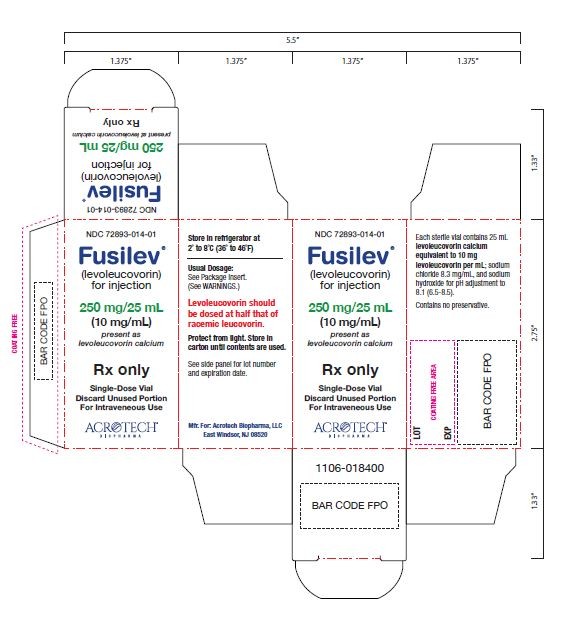
Contents
- 1 Fusilev (levoleucovorin)
- 1.0.1 Side Effects of Fusilev
- 1.0.2 Dosage for Fusilev
- 1.0.2.1 Important Use Information
- 1.0.2.2 Co-Administration of Fusilev with Other Agents
- 1.0.2.3 Recommended Dosage for Rescue After High-Dose Methotrexate Therapy
- 1.0.2.4 Recommended Dosage for Overdosage of Folic Acid Antagonists or Impaired Methotrexate Elimination
- 1.0.2.5 Dosage in Combination with Fluorouracil for Metastatic Colorectal Cancer
- 1.0.2.6 Preparation for Administration
- 1.0.3 Drug Interactions with Fusilev
- 1.0.4 Is Fusilev Safe to Use While Pregnant or Breastfeeding?
Fusilev (levoleucovorin)
Fusilev (levoleucovorin) is a derivative of folic acid indicated for the treatment of metastatic colorectal cancer and bone cancer (after methotrexate therapy).
Side Effects of Fusilev
Common side effects of Fusilev include:
- nausea
- vomiting
- diarrhea
- stomach pain
- upset stomach
- numbness or tingling
- loss of appetite
- unusual or unpleasant taste in your mouth
- weakness
- tired feeling
- hair loss, or
- mild skin rash.
Seizures and fainting, though rare, have been reported in patients taking Fusilev.
Dosage for Fusilev
Important Use Information
- Fusilev is indicated for intravenous administration only. Do not administer intrathecally.
Co-Administration of Fusilev with Other Agents
- Due to the risk of precipitation, do not co-administer Fusilev with other agents in the same admixture.
Recommended Dosage for Rescue After High-Dose Methotrexate Therapy
- The recommended dosage for Fusilev is based on a methotrexate dose of 12 grams/m2 administered by intravenous infusion over 4 hours. Twenty-four hours after starting the methotrexate infusion, initiate Fusilev at a dose of 7.5 mg (approximately 5 mg/m2) as an intravenous infusion every 6 hours.
- Monitor serum creatinine and methotrexate levels at least once daily. Continue Fusilev administration, hydration, and urinary alkalinization (pH of 7 or greater) until the methotrexate level is below 5 x 10-8 M (0.05 micromolar). Adjust the Fusilev dose or extend the duration as recommended in Table 1.
Table 1 Recommended Dosage for Fusilev based on Serum Methotrexate and Creatinine Levels
| Clinical Situation | Laboratory Findings | Recommendation |
| Normal Methotrexate Elimination | Serum methotrexate level approximately 10 micromolar at 24 hours after administration, 1 micromolar at 48 hours, and less than 0.2 micromolar at 72 hours | Administer 7.5 mg by intravenous infusion every 6 hours for 60 hours (10 doses starting at 24 hours after start of methotrexate infusion). |
| Delayed Late Methotrexate Elimination | Serum methotrexate level remaining above 0.2 micromolar at 72 hours, and more than 0.05 micromolar at 96 hours after administration. | Continue 7.5 mg by intravenous infusion every 6 hours until methotrexate level is less than 0.05 micromolar. |
| Delayed Early Methotrexate Elimination and/or Evidence of Acute Renal Injury* | Serum methotrexate level of 50 micromolar or more at 24 hours, or 5 micromolar or more at 48 hours after administration | Administer 75 mg by intravenous infusion every 3 hours until methotrexate level is less than 1 micromolar; then 7.5 mg by intravenous infusion every 3 hours until methotrexate level is less than 0.05 micromolar. |
| * These patients are likely to develop reversible renal failure. In addition to appropriate Fusilev therapy, continue hydration and urinary alkalinization and monitor fluid and electrolyte status, until the serum methotrexate level has fallen to below 0.05 micromolar and the renal failure has resolved. | ||
Impaired Methotrexate Elimination or Renal Impairment
- Decreased methotrexate elimination or renal impairment which are clinically important but less severe than the abnormalities described in Table 1 can occur following methotrexate administration.
- If toxicity associated with methotrexate is observed, in subsequent courses extend Fusilev rescue for an additional 24 hours (total of 14 doses over 84 hours).
Third-Space Fluid Collection and Other Causes of Delayed Methotrexate Elimination
- Accumulation in a third-space fluid collection (i.e., ascites, pleural effusion), renal insufficiency, or inadequate hydration can delay methotrexate elimination.
- Under such circumstances, higher doses of Fusilev or prolonged administration may be indicated.
Recommended Dosage for Overdosage of Folic Acid Antagonists or Impaired Methotrexate Elimination
Start Fusilev as soon as possible after an overdosage of methotrexate or within 24 hours of methotrexate administration when methotrexate elimination is impaired. As the time interval between methotrexate administration and Fusilev increases, the effectiveness of Fusilev to diminish methotrexate toxicity may decrease. Administer Fusilev 7.5 mg (approximately 5 mg/m2) by intravenous infusion every 6 hours until the serum methotrexate level is less than 5 x 10-8 M (0.05 micromolar).
Monitor serum creatinine and methotrexate levels at least every 24 hours. Increase the dosage of Fusilev to 50 mg/m2 intravenously every 3 hours and continue Fusilev at this dosage until the methotrexate level is less than 5 x 10-8 M for the following:
- if serum creatinine at 24-hours increases 50% or more compared to baseline
- if the methotrexate level at 24-hours is greater than 5 x 10-6 M
- if the methotrexate level at 48-hours is greater than 9 x 10-7 M,
Continue concomitant hydration (3 L per day) and urinary alkalinization with sodium bicarbonate. Adjust the sodium bicarbonate dose to maintain urine pH at 7 or greater.
Dosage in Combination with Fluorouracil for Metastatic Colorectal Cancer
The following regimens have been used for the treatment of colorectal cancer:
- Fusilev 100 mg/m2 by intravenous injection over a minimum of 3 minutes, followed by fluorouracil at 370 mg/m2 by intravenous injection, once daily for 5 consecutive days.
- Fusilev 10 mg/m2 by intravenous injection, followed by fluorouracil 425 mg/m2 by intravenous injection, once daily for 5 consecutive days.
Administer fluorouracil and Fusilev separately to avoid the formation of a precipitate.
This five-day course may be repeated every 4 weeks for 2 courses, then every 4 to 5 weeks, if the patient has recovered from the toxicity from the prior course. Do not adjust Fusilev dosage for toxicity.
Refer to fluorouracil prescribing information for information on fluorouracil dosage and dosage modifications for adverse reactions.
Preparation for Administration
Fusilev for Injection
- Prior to intravenous injection, reconstitute the 50 mg vial of Fusilev for Injection with 5.3 mL of 0.9% Sodium Chloride Injection, USP to yield a levoleucovorin concentration of 10 mg per mL. Reconstitution with Sodium Chloride solutions with preservatives (e.g. benzyl alcohol) has not been studied. The use of solutions other than 0.9% Sodium Chloride Injection, USP is not recommended.
- The reconstituted 10 mg per mL levoleucovorin contains no preservative. Observe strict aseptic technique during reconstitution of the drug product. Discard unused portion.
- Saline reconstituted levoleucovorin solutions may be further diluted, immediately, to concentrations of 0.5 mg/mL to 5 mg/mL in 0.9% Sodium Chloride Injection, USP or 5% Dextrose Injection, USP. Do not store the reconstituted product or reconstituted product diluted using 0.9% Sodium Chloride Injection, USP for more than 12 hours at room temperature. Do not store reconstituted product diluted using 5% Dextrose Injection, USP for more than 4 hours at room temperature.
- Visually inspect the reconstituted solution for particulate matter and discoloration prior to administration. Do not use if cloudiness or precipitate is observed.
- Do not intravenously inject more than 16 mL of reconstituted solutions (160 mg of levoleucovorin) per minute, because of the calcium content of the levoleucovorin solution.
Fusilev Injection
- Levoleucovorin contains no preservative. Observe strict aseptic technique during reconstitution of the drug product. Discard unused portion.
- Levoleucovorin solutions may be further diluted to concentrations of 0.5 mg/mL in 0.9% Sodium Chloride Injection, USP or 5% Dextrose Injection, USP. Do not store the product diluted using 0.9% Sodium Chloride Injection, USP or 5% Dextrose Injection, USP for more than 4 hours at room temperature.
- Visually inspect the diluted solution for particulate matter and discoloration prior to administration. Do not use if cloudiness or precipitate is observed.
- Inject no more than 16 mL of Fusilev Injection (160 mg of levoleucovorin) intravenously per minute, because of the calcium content of the levoleucovorin solution.
Drug Interactions with Fusilev
Effects of Leucovorin Products on Other Drugs
Antiepileptic Drugs
- Folic acid in large amounts may counteract the antiepileptic effect of phenobarbital, phenytoin, and primidone and increase the frequency of seizures in susceptible children.
- It is not known whether folinic acid has the same effects; however, both folic and folinic acids share some common metabolic pathways. Monitor patients taking folinic acid in combination with antiepileptic drugs.
Fluorouracil
- Leucovorin products increase the toxicity of fluorouracil. Do not initiate or continue therapy with Fusilev and fluorouracil in patients with symptoms of gastrointestinal toxicity until those symptoms have resolved.
- Monitor patients with diarrhea until the diarrhea has resolved, as rapid deterioration leading to death can occur.
Trimethoprim-Sulfamethoxazole
- The concomitant use of d,l-leucovorin with trimethoprim-sulfamethoxazole for the acute treatment of Pneumocystis jiroveci pneumonia in patients with HIV infection was associated with increased rates of treatment failure and morbidity in a placebo-controlled study.
Is Fusilev Safe to Use While Pregnant or Breastfeeding?
- There are limited data with Fusilev use in pregnant women. Levoleucovorin is administered in combination with methotrexate or fluorouracil, which can cause embryo-fetal harm.
- Refer to methotrexate and fluorouracil prescribing information for additional information.
- There are no data on the presence of levoleucovorin in human milk or its effects on the breastfed infant or on milk production.
- Levoleucovorin is administered in combination with methotrexate or fluorouracil.
- Refer to methotrexate and fluorouracil prescribing information for additional information.


